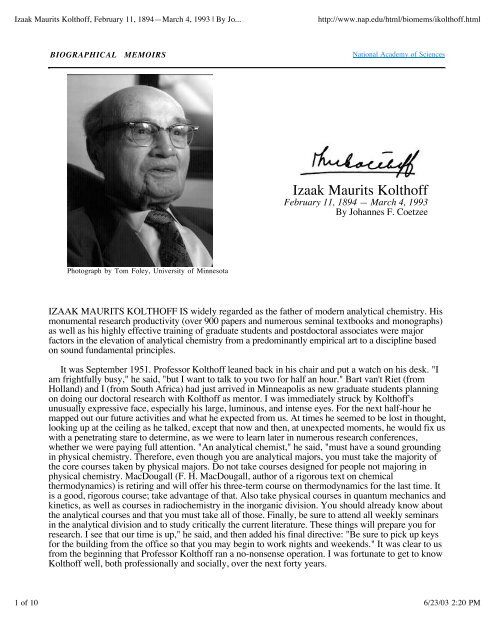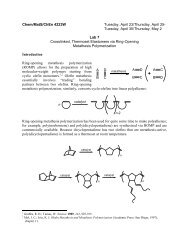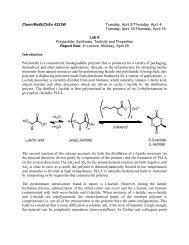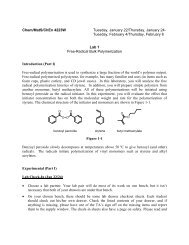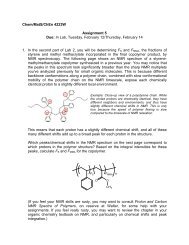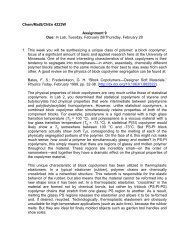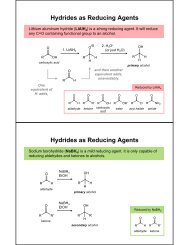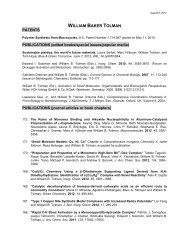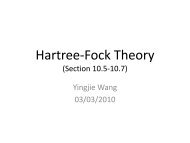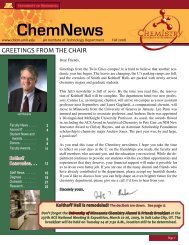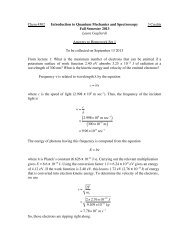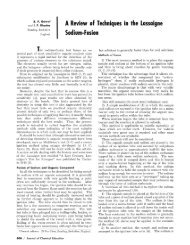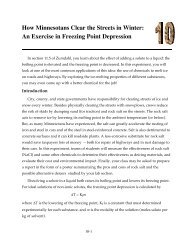Izaak Maurits Kolthoff - University of Minnesota
Izaak Maurits Kolthoff - University of Minnesota
Izaak Maurits Kolthoff - University of Minnesota
- No tags were found...
You also want an ePaper? Increase the reach of your titles
YUMPU automatically turns print PDFs into web optimized ePapers that Google loves.
<strong>Izaak</strong> <strong>Maurits</strong> <strong>Kolth<strong>of</strong>f</strong>, February 11, 1894—March 4, 1993 | By Jo...http://www.nap.edu/html/biomems/ikolth<strong>of</strong>f.htmlBIOGRAPHICAL MEMOIRSNational Academy <strong>of</strong> Sciences<strong>Izaak</strong> <strong>Maurits</strong> <strong>Kolth<strong>of</strong>f</strong>February 11, 1894 — March 4, 1993By Johannes F. CoetzeePhotograph by Tom Foley, <strong>University</strong> <strong>of</strong> <strong>Minnesota</strong>IZAAK MAURITS KOLTHOFF IS widely regarded as the father <strong>of</strong> modern analytical chemistry. Hismonumental research productivity (over 900 papers and numerous seminal textbooks and monographs)as well as his highly effective training <strong>of</strong> graduate students and postdoctoral associates were majorfactors in the elevation <strong>of</strong> analytical chemistry from a predominantly empirical art to a discipline basedon sound fundamental principles.It was September 1951. Pr<strong>of</strong>essor <strong>Kolth<strong>of</strong>f</strong> leaned back in his chair and put a watch on his desk. "Iam frightfully busy," he said, "but I want to talk to you two for half an hour." Bart van't Riet (fromHolland) and I (from South Africa) had just arrived in Minneapolis as new graduate students planningon doing our doctoral research with <strong>Kolth<strong>of</strong>f</strong> as mentor. I was immediately struck by <strong>Kolth<strong>of</strong>f</strong>'sunusually expressive face, especially his large, luminous, and intense eyes. For the next half-hour hemapped out our future activities and what he expected from us. At times he seemed to be lost in thought,looking up at the ceiling as he talked, except that now and then, at unexpected moments, he would fix uswith a penetrating stare to determine, as we were to learn later in numerous research conferences,whether we were paying full attention. "An analytical chemist," he said, "must have a sound groundingin physical chemistry. Therefore, even though you are analytical majors, you must take the majority <strong>of</strong>the core courses taken by physical majors. Do not take courses designed for people not majoring inphysical chemistry. MacDougall (F. H. MacDougall, author <strong>of</strong> a rigorous text on chemicalthermodynamics) is retiring and will <strong>of</strong>fer his three-term course on thermodynamics for the last time. Itis a good, rigorous course; take advantage <strong>of</strong> that. Also take physical courses in quantum mechanics andkinetics, as well as courses in radiochemistry in the inorganic division. You should already know aboutthe analytical courses and that you must take all <strong>of</strong> those. Finally, be sure to attend all weekly seminarsin the analytical division and to study critically the current literature. These things will prepare you forresearch. I see that our time is up," he said, and then added his final directive: "Be sure to pick up keysfor the building from the <strong>of</strong>fice so that you may begin to work nights and weekends." It was clear to usfrom the beginning that Pr<strong>of</strong>essor <strong>Kolth<strong>of</strong>f</strong> ran a no-nonsense operation. I was fortunate to get to know<strong>Kolth<strong>of</strong>f</strong> well, both pr<strong>of</strong>essionally and socially, over the next forty years.1 <strong>of</strong> 10 6/23/03 2:20 PM
<strong>Izaak</strong> <strong>Maurits</strong> <strong>Kolth<strong>of</strong>f</strong>, February 11, 1894—March 4, 1993 | By Jo...http://www.nap.edu/html/biomems/ikolth<strong>of</strong>f.html<strong>Izaak</strong> <strong>Maurits</strong> <strong>Kolth<strong>of</strong>f</strong>, son <strong>of</strong> Moses and Rosetta (née Wysenbeck) <strong>Kolth<strong>of</strong>f</strong>, was born in Almelo,Netherlands, on February 11, 1894, the youngest <strong>of</strong> three children. His father was highly orthodox, hismother much less so. His brother and sister, and later <strong>Kolth<strong>of</strong>f</strong> himself, gradually became more andmore liberal. During his kindergarten days he acquired the nickname "Piet," apparently for no particularreason, and he was called by this nickname by almost everyone. During his first chemistry course inhigh school he developed a keen interest in the subject and appropriated part <strong>of</strong> the kitchen for hislaboratory. Some <strong>of</strong> his experiments involved hydrogen sulfide, to the dismay <strong>of</strong> his family. Aftergraduating from high school in 1911 he entered the School <strong>of</strong> Pharmacy at the <strong>University</strong> <strong>of</strong> Utrecht.The reason he began his studies in pharmacy rather than chemistry was that he lacked Latin and Greek,which at that time were prerequisites for admission to the "pure" physical sciences. Nevertheless, healready was reasonably fluent in German, French, and English, in addition to his native Dutch. It isinteresting to speculate about the direction <strong>Kolth<strong>of</strong>f</strong>'s career would have taken if he had had the requiredcompetence in Latin and Greek. The pharmacy curriculum at Utrecht was thorough and involved a greatdeal <strong>of</strong> analytical chemistry. Furthermore, <strong>Kolth<strong>of</strong>f</strong> was greatly influenced by pharmacy pr<strong>of</strong>essorNicholas Schoorl, who emphasized a proper balance between descriptive chemistry and the fundamentalprinciples <strong>of</strong> the field. At that time analytical chemistry tended to be largely empirical, and Schoorl'sattention to the principles <strong>of</strong> chemistry was unusual. In his future career <strong>Kolth<strong>of</strong>f</strong> similarly emphasizedfundamental principles, but he had an open mind about current hypotheses. He would <strong>of</strong>ten speculateabout the probable outcome <strong>of</strong> experiments, but when unexpected results were obtained he would beentirely magnanimous in abandoning the assumptions on which his predictions had been based.In 1915 <strong>Kolth<strong>of</strong>f</strong> received his "apotheker" diploma. He then took more courses at Utrecht, both inphysical and colloid chemistry. He was impressed by the famous colloid chemist H. R. Kruyt and laterdid extensive research involving colloids. Also in 1915 <strong>Kolth<strong>of</strong>f</strong> published his first paper on thethen-novel concept <strong>of</strong> pH introduced by S. P. L. Sørensen. In 1918 the requirement for Latin and Greekwas abandoned by the <strong>University</strong> <strong>of</strong> Utrecht and <strong>Kolth<strong>of</strong>f</strong> received the Ph.D. degree in chemistry with athesis titled "Fundamentals <strong>of</strong> Iodimetry." By then he had published 32 papers, all on subjects differentfrom his Ph.D. research. He remained at the <strong>University</strong> <strong>of</strong> Utrecht, first as "conservator" and then, from1923 until 1927, as "privaat docent" (lecturer) in electrochemistry. The significance <strong>of</strong> the pH conceptwas not generally recognized at that time, and <strong>Kolth<strong>of</strong>f</strong> gave many lectures on it to academic andindustrial chemists, biochemists (especially bacteriologists), and pharmacists. At the same time hisresearch productivity was astronomical. During the ten-year period from 1917 until 1927 he published270 papers and 3 books, but it was the originality, insight, and timeliness rather than the mere bulk <strong>of</strong>these publications that created an enviable international reputation for <strong>Kolth<strong>of</strong>f</strong> at an early age. Themajority <strong>of</strong> his early publications were in Dutch, German, or French and, after 1924, increasingly inEnglish.In 1924 <strong>Kolth<strong>of</strong>f</strong> was invited on a lecture tour in Canada and the United States, and in 1927 he was<strong>of</strong>fered a one-year appointment as pr<strong>of</strong>essor and chief <strong>of</strong> the Analytical Division <strong>of</strong> the School <strong>of</strong>Chemistry <strong>of</strong> the <strong>University</strong> <strong>of</strong> <strong>Minnesota</strong> (annual salary $4,500). In his letter <strong>of</strong> acceptance hepromised, "I may assure you that [on] my side I will try to do my duty as well as possible and I hopethat your expectations will not be disappointed." His one-year appointment became permanent and heremained at <strong>Minnesota</strong> until his nominal retirement in 1962 despite attempts by other institutions(including his alma mater, the <strong>University</strong> <strong>of</strong> Utrecht) to attract him. That <strong>Kolth<strong>of</strong>f</strong> fully lived up to hispromise can be illustrated, in part, by the following statistics. At the time <strong>of</strong> his retirement he hadpublished 809 research papers. During the next approximately 30 years, mainly in collaboration with hissenior postdoctoral associate Miran K. Chantooni, Jr., he published another 136 papers. Over the period1924-55 he authored or coauthored 8 textbooks and monographs, several in multiple volumes andeditions, and from 1959 until 1980 he coedited 34 volumes <strong>of</strong> reference books. Finally, many <strong>of</strong> his 67graduate students entered academia, with the result that by 1993 <strong>Kolth<strong>of</strong>f</strong>'s academic descendants withPh.D. degrees numbered almost 1,500. 1 All <strong>of</strong> this, however, is only part <strong>of</strong> the <strong>Kolth<strong>of</strong>f</strong> legacy, as willbe elaborated below.<strong>Kolth<strong>of</strong>f</strong> and analytical chemistry were fortunate, in a sense, that he appeared on the scene at an2 <strong>of</strong> 10 6/23/03 2:20 PM
<strong>Izaak</strong> <strong>Maurits</strong> <strong>Kolth<strong>of</strong>f</strong>, February 11, 1894—March 4, 1993 | By Jo...http://www.nap.edu/html/biomems/ikolth<strong>of</strong>f.htmlstudy <strong>of</strong> the formation and properties <strong>of</strong> precipitates. In 1920-21 he published a set <strong>of</strong> 9 papers onthe significance <strong>of</strong> adsorption in analytical chemistry. After a lapse <strong>of</strong> 11 years he returned to thisfield with a vengeance, then at the <strong>University</strong> <strong>of</strong> <strong>Minnesota</strong>. Fresh crystalline precipitates tend tobe highly imperfect, but above ambient temperatures "aging" occurs, whereby purification byrecrystallization takes place. This process was studied with radiotracers, thorium B for lead andbromine activated by neutrons from a radon-beryllium source. Surface areas were measured bydye adsorption. During the period 1932-48 he published 37 papers on aging <strong>of</strong> precipitates andcoprecipitation. He continued with these studies, but on a smaller scale, until 1960. Theseinvestigations were fundamental, rather than applied, and attracted much attention (e.g., by OttoHahn).4. Voltammetry. <strong>Kolth<strong>of</strong>f</strong> became interested in voltammetry in 1933 when J. Heyrovsky, theinventor <strong>of</strong> polarography (voltammetry at the dropping mercury electrode) and future Nobellaureate, visited Minneapolis. Two <strong>of</strong> <strong>Kolth<strong>of</strong>f</strong>'s top students, J. J. Lingane (Ph.D., 1938) and H.A. Laitinen (Ph.D., 1940) began working on voltammetry, Lingane on the fundamentals <strong>of</strong> thedropping mercury electrode, Laitinen on solid microelectrodes. In 1939 <strong>Kolth<strong>of</strong>f</strong> and Linganepublished a 94-page paper in Chemical Reviews. This was followed in 1941 by an influentialmonograph with Lingane as coauthor, Polarography (Interscience, New York), expanded in1952 into two volumes. <strong>Kolth<strong>of</strong>f</strong> with several <strong>of</strong> his students continued to study voltammetry,both in aqueous and nonaqueous solutions, into the 1960s.5. Emulsion polymerization. In 1942 the Office <strong>of</strong> Rubber Reserve was set up to promote theproduction <strong>of</strong> synthetic rubber as a crucial part <strong>of</strong> the war effort. <strong>Kolth<strong>of</strong>f</strong> was one <strong>of</strong> severalprominent pr<strong>of</strong>essors, including physical chemist P. Debye, organic chemists M. Karasch and C.S. Marvel, and colloid chemists W. D. Harkins and J. W. McBain, invited to work with the majorrubber companies. <strong>Kolth<strong>of</strong>f</strong> was asked to develop analytical methods so that the rates at whichreactants were consumed could be determined. A key constituent turned out to be n-dodecylmercaptan, referred to as "OEI," for "one essential ingredient." 6 <strong>Kolth<strong>of</strong>f</strong> quickly developed aneffective method for the determination <strong>of</strong> OEI based on amperometric titration at the rotatedplatinum microelectrode with silver nitrate. This method found worldwide use after the war, whenit was published (1946). In typical fashion, immediately following this important applied research,<strong>Kolth<strong>of</strong>f</strong> launched a thorough fundamental investigation into factors influencing the rates <strong>of</strong>reaction <strong>of</strong> mercaptans, as well as the kinetics and mechanism <strong>of</strong> emulsion polymerization ingeneral. These studies led to the development <strong>of</strong> novel initiating systems that worked at lowertemperatures than usual and that produced so-called "cold rubber" with superior properties. In thisfield <strong>Kolth<strong>of</strong>f</strong> published, in addition to a number <strong>of</strong> significant papers, a monograph coauthoredwith F. A. Bovey, A. I. Medalia, and E. J. Meehan, Emulsion Polymerization (Interscience, NewYork, 1955).6. Induced reactions. <strong>Kolth<strong>of</strong>f</strong> studied a number <strong>of</strong> these reactions; one example follows.Typical <strong>of</strong> numerous induced reactions is the iron(II)-hydrogen peroxide (Fenton) reaction.<strong>Kolth<strong>of</strong>f</strong> and Medalia (1949) showed that hydroxyl radicals produced in the first step can inducethe oxidation <strong>of</strong> many organic compounds.7. Compounds containing sulfhydryl and disulfide groups. Beginning in 1950 andcontinuing until 1980 <strong>Kolth<strong>of</strong>f</strong> carried out extensive studies <strong>of</strong> the reactivity <strong>of</strong> these groups innative and denatured albumin. These papers may be among the first in bioelectrochemistry, anactive field at the present time.8. Chemistry <strong>of</strong> nonaqueous solutions. <strong>Kolth<strong>of</strong>f</strong> did much to rectify the paradox that thechemistry <strong>of</strong> solutions as typically presented in textbooks and elsewhere had (and to some extentstill has) what may be called a strong aquacentric bias, even though the majority <strong>of</strong> reactions insolution were carried out in nonaqueous media and, furthermore, water was (and is) the mostatypical <strong>of</strong> solvents. His interest in the subject dated back to the early 1930s (1931, 1934), but it4 <strong>of</strong> 10 6/23/03 2:20 PM
<strong>Izaak</strong> <strong>Maurits</strong> <strong>Kolth<strong>of</strong>f</strong>, February 11, 1894—March 4, 1993 | By Jo...http://www.nap.edu/html/biomems/ikolth<strong>of</strong>f.htmlwas not until the early 1950s that he began a long series <strong>of</strong> fundamental studies <strong>of</strong> how solventsinfluence the properties <strong>of</strong> solutes. Particularly noteworthy were five classical papers in 1956-57with Stanley Bruckenstein on acid-base equilibria in glacial acetic acid, in which the complexinteractions occurring in this solvent were quantitatively interpreted. In particular, thecontributions <strong>of</strong> proton transfer (ionization <strong>of</strong> Brønsted acids) followed by electrolyticdissociation were resolved. These studies were followed by a long series <strong>of</strong> investigations <strong>of</strong> abroad spectrum <strong>of</strong> solute-solvent interactions in various dipolar aprotic solvents, beginning withacetonitrile in 1957. This important solvent, which later became the workhorse <strong>of</strong> electrochemists,was studied in great detail well into the 1980s, particularly with M. K. Chantooni, Jr., ascoworker. Parallel studies were carried out by a number <strong>of</strong> other research groups in severalcountries, but <strong>Kolth<strong>of</strong>f</strong>'s contributions were among the most significant. During the course <strong>of</strong> thiswork <strong>Kolth<strong>of</strong>f</strong> became interested in the macrocyclic ligands (crown ethers and cryptates)introduced by J. Pedersen in 1967 and carried out extensive investigations <strong>of</strong> the reactions <strong>of</strong>these ligands in various solvents. In 1979 he wrote a critical and stimulating review <strong>of</strong>applications <strong>of</strong> these ligands in analytical chemistry, incorporating in his characteristic fashionmany suggestions for future work. <strong>Kolth<strong>of</strong>f</strong>'s fundamental studies in nonaqueous solventsoccupied him until the end <strong>of</strong> his long and fruitful career in 1993 and produced a greater number<strong>of</strong> publications than any other topic studied by him.<strong>Kolth<strong>of</strong>f</strong> generally produced a monograph on every subject on which he had done extensiveresearch. These books had significant impact, and the majority was translated into several languages.His monographs on conductometric titrations, potentiometric titrations, indicators, classical volumetricanalysis, polarography, and emulsion polymerization already have been mentioned.In 1931 he published his first book intended primarily as a text, The Colorimetric and PotentiometricDetermination <strong>of</strong> pH. A second edition coauthored by H. A. Laitinen, pH and Electrotitrations (JohnWiley, New York), appeared in 1941. Particularly noteworthy was the publication <strong>of</strong> a second text,Textbook <strong>of</strong> Quantitative Inorganic Analysis (Macmillan, New York, 1936) by <strong>Kolth<strong>of</strong>f</strong> and E. B.Sandell (<strong>Kolth<strong>of</strong>f</strong>'s first graduate student [Ph.D., 1932] and pr<strong>of</strong>essor at the <strong>University</strong> <strong>of</strong> <strong>Minnesota</strong>).This text was destined to become a seminal influence in the teaching <strong>of</strong> undergraduate analyticalchemistry. It presented an admirable balance between the fundamentals and the experimental features <strong>of</strong>the field and repeated <strong>Kolth<strong>of</strong>f</strong>'s motto, which had first appeared in Massanalyse: "Theory guides,experiment decides." This text was a quantum jump ahead <strong>of</strong> existing books and served as a model forfuture texts over many years. In my own case, it was the major cause <strong>of</strong> a change in career plans. Forthe first time, it was clear that someone actually understood the reasons for the experimental details inanalytical procedures. Particularly noteworthy was the inclusion <strong>of</strong> numerous references to the originalliterature, many to research by <strong>Kolth<strong>of</strong>f</strong> himself. After reading a number <strong>of</strong> these, I decided to do mydoctoral research with <strong>Kolth<strong>of</strong>f</strong>, and so I became an analytical chemist rather than a synthetic organicchemist as planned until then.The most monumental <strong>of</strong> <strong>Kolth<strong>of</strong>f</strong>'s productions is his Treatise on Analytical Chemistry (JohnWiley, New York) in three parts coedited with P. J. Elving (<strong>University</strong> <strong>of</strong> Michigan) and others in latervolumes. Part I deals with the general fundamentals <strong>of</strong> the field and was published over the period1959-76 in 11 volumes. These reference books were so well received that an expanded second editionsoon followed, appearing in 14 volumes until 1986. Part II deals with the analytical chemistry <strong>of</strong> organicand inorganic compounds in more specific terms and appeared over the period 1961-80 in 16 volumes.Finally, Part III concerns analytical chemistry in industry, with four volumes appearing until 1977. Thistreatise is the principal reference source <strong>of</strong> analytical chemistry and it has had a huge impact.The significance <strong>of</strong> <strong>Kolth<strong>of</strong>f</strong>'s prodigious output <strong>of</strong> research papers, textbooks and reference bookscan be summarized by quoting Lingane. 4 "Analytical chemistry has never been served by a moreoriginal mind, nor a more prolific pen, than <strong>Kolth<strong>of</strong>f</strong>'s."<strong>Kolth<strong>of</strong>f</strong> received numerous awards and other honors, including three awards from the American5 <strong>of</strong> 10 6/23/03 2:20 PM
<strong>Izaak</strong> <strong>Maurits</strong> <strong>Kolth<strong>of</strong>f</strong>, February 11, 1894—March 4, 1993 | By Jo...http://www.nap.edu/html/biomems/ikolth<strong>of</strong>f.htmlChemical Society (Nichols Award [1949], Fisher Award in Analytical Chemistry [1950], and theWillard Gibbs Medal [1964]), the Electrochemical Society Olin-Palladium Medal (1981), and thePittsburgh Analytical Chemistry Award (1981), as well as honorary doctor's degrees from the<strong>University</strong> <strong>of</strong> Chicago, Brandeis <strong>University</strong>, <strong>University</strong> <strong>of</strong> Arizona, <strong>University</strong> <strong>of</strong> Groningen(Netherlands), and the Hebrew <strong>University</strong> <strong>of</strong> Jerusalem. He was the recipient <strong>of</strong> numerous other honorsfrom chemical societies and universities abroad. In 1938 he was knighted to the Order <strong>of</strong> Oranje-Nassau<strong>of</strong> the Netherlands, and in 1947 he was elevated to a commander <strong>of</strong> the same order by the Dutch queen.He was elected to the National Academy <strong>of</strong> Sciences in 1958.One would expect that <strong>Kolth<strong>of</strong>f</strong>'s prodigious output could be accomplished only by running a large,efficient, and hard-driven operation. This indeed was the case in the latter two respects, but <strong>Kolth<strong>of</strong>f</strong>'sprogram was never particularly large. Nor were his interests <strong>of</strong> a routine nature that could lead to a largeoutput with little effort. Instead they were strongly focused on the elucidation <strong>of</strong> significant and complexproblems. The efficiency <strong>of</strong> his program derived from his talent for finding the most direct route towardsolution <strong>of</strong> a problem. While current analytical chemistry is strongly (arguably too strongly)instrumentation-oriented, <strong>Kolth<strong>of</strong>f</strong>'s work was chemistry-oriented. Much <strong>of</strong> his research was donebefore the great influx <strong>of</strong> increasingly sophisticated instrumentation after World War II. For him,instrumentation was a means to an end, not an end in itself. Nevertheless, he used the complementaryfeatures <strong>of</strong> different types <strong>of</strong> instrumentation available to him to great advantage, e.g., conductometry,potentiometry, voltammetry, and ultraviolet-visible spectrophotometry in addressing the dauntingproblems <strong>of</strong> nonaqueous solution chemistry.<strong>Kolth<strong>of</strong>f</strong>'s personal work habits were unusual. He would begin his workday by spending a couple <strong>of</strong>hours reading abstracts, papers, and research reports in the seclusion <strong>of</strong> his apartment in the FacultyClub <strong>of</strong> the university. At the same time he would write directives to his coworkers for future work onnotepaper printed at the top "From the desk <strong>of</strong> I. M. <strong>Kolth<strong>of</strong>f</strong>." All <strong>of</strong> us would find these notes on ourdesks later in the day. <strong>Kolth<strong>of</strong>f</strong> would not arrive in his <strong>of</strong>fice until 10:30 or 11:00. He would first dictateletters to his secretary, the highly competent Christa Elguther. He was a prolific correspondent andanswered letters punctually. During the afternoons he would have individual research conferences withhis graduate students and postdoctoral associates. The schedule in my own case was that I would turn inmy weekly progress report on Wednesdays. This always would be returned to me on Thursdays,annotated in the margins and sometimes across the text with numerous comments, suggestions, anddirectives. During Friday afternoons, I would meet with <strong>Kolth<strong>of</strong>f</strong> for half an hour to discuss the report.He evaluated everything in a highly critical way, but the majority <strong>of</strong> us understood the need for that.Some <strong>of</strong> his suggestions were monumental in scope, requiring good fortune and several months <strong>of</strong> hardwork, but they were presented with the clear expectation <strong>of</strong> a rapid solution. We all lamented suchunrealistic expectations. Towards the end <strong>of</strong> my four-year stay Stanley Bruckenstein (cozily finishedwith his research) gave me some sage advice: "When <strong>Kolth<strong>of</strong>f</strong> mentions a particularly daunting task,keep it in mind but do not necessarily work on it. If he mentions it a second time, begin working on it,and if he refers to it a third time you better have results to report." I only wish Stanley had divulged thisto me earlier in my career. Perhaps we worried too much about some <strong>of</strong> <strong>Kolth<strong>of</strong>f</strong>'s apparently unrealisticexpectations. One Friday afternoon he mapped out a new and wide-ranging investigation. As he wastalking, I was thinking, "I hope I will have something significant to report a month from now."<strong>Kolth<strong>of</strong>f</strong>, however, concluded by saying, "I travel to Iowa State tomorrow morning at 9 o'clock. Cometo the airport and report what you have found." After some soul searching I decided to ignore thisdirective. He never mentioned it again.<strong>Kolth<strong>of</strong>f</strong> could be harsh with his coworkers. I believe he did not fully realize just how intimidatinghe could be. Quite <strong>of</strong>ten after research conferences some <strong>of</strong> his graduate students and postdoctoralassociates appeared to be in a state <strong>of</strong> shock. <strong>Kolth<strong>of</strong>f</strong>, in turn, would grumble afterwards about "a tale<strong>of</strong> woe" and "babe in the woods." Nevertheless, the great majority <strong>of</strong> his coworkers became his devotedfriends after they left. <strong>Kolth<strong>of</strong>f</strong>, in turn, expended great effort in promoting their careers, at least forthose people who had satisfied him that they were serious pr<strong>of</strong>essionals. I was fortunate in getting toknow him well over a period <strong>of</strong> 40 years. He was a longtime friend <strong>of</strong> my parents-in-law, the Luytens,who were also natives <strong>of</strong> Holland. He would <strong>of</strong>ten visit to talk (in Dutch, mostly about politics and6 <strong>of</strong> 10 6/23/03 2:20 PM
<strong>Izaak</strong> <strong>Maurits</strong> <strong>Kolth<strong>of</strong>f</strong>, February 11, 1894—March 4, 1993 | By Jo...http://www.nap.edu/html/biomems/ikolth<strong>of</strong>f.htmladministrators <strong>of</strong> all kinds), to drink "jenever" (Dutch gin), to eat such favorite dishes as "hutspot metboerenkool" (kale, potatoes and sausage), and to lament the slow progress <strong>of</strong> his research. On one suchoccasion he confided in me: "I could have accomplished much more if I had worked harder." I was at atotal loss how to reply.After I became a faculty member at the <strong>University</strong> <strong>of</strong> Pittsburgh my contacts with <strong>Kolth<strong>of</strong>f</strong>continued. My wife and I visited her parents in Minneapolis every year, and <strong>of</strong>ten <strong>Kolth<strong>of</strong>f</strong> would be intown. He would always say, "I will set aside a day to talk about our research." I would then spendseveral hours <strong>of</strong> stimulating discussions with <strong>Kolth<strong>of</strong>f</strong> and sometimes with his dedicated coworkerMiran Chantooni. The last time we had such a discussion was on the occasion <strong>of</strong> his ninetieth birthday.I met him in the Campus Club. He was scowling at a reprint. Many other reprints were scattered ontables and even on the floor. Immediately after greeting me he lamented, in typical fashion, "I do notunderstand a word <strong>of</strong> this--I think everything is wrong."<strong>Kolth<strong>of</strong>f</strong>'s monumental pr<strong>of</strong>essional contributions were accomplished in spite <strong>of</strong> a number <strong>of</strong>physical limitations. In his younger days he was quite a sportsman, enjoying swimming, tennis, skiing,and horseback riding. Then, in 1942, when he was forty-eight years old, he was injured in a skiingaccident. This was aggravated when he was later thrown from a horse. He had spinal surgery and endedup partially paralyzed, but intensive rehabilitation aided by his indomitable willpower improved hiscondition until he could manage with just a brace on his leg, although he then walked with a pronouncedand permanent limp. He also suffered from essential hypertension and frequent bouts with pneumoniathat landed him in the hospital. His confinements did not deter him, however, from having daily researchconferences without much regard for visiting hours. After his accidents he had to abandon some <strong>of</strong> hisphysical activities, but he continued swimming and even horseback riding. When he was seventy yearsold he gave a talk in Houston and then stopped for a week's respite at a ranch called "WhisperingWinds." Here he made a big impression and became known as "Nature Boy" because <strong>of</strong> his strenuousprogram: 45 minutes <strong>of</strong> exercise before breakfast, followed by 4 to 5 hours in the saddle and finally abrisk swim. A newspaper reported: "Dr. Kolthopp (sic), Noted Chemist, Visits in Bandera Last Week."I have seen a clipping <strong>of</strong> this article on which <strong>Kolth<strong>of</strong>f</strong> had scribbled an addition to the headline: "Dr.Kolthopp, on a Horse."<strong>Kolth<strong>of</strong>f</strong> never married but led an active social life. He had broad cultural and political interests. Heparticularly appreciated classical music and for many years regularly attended concerts <strong>of</strong> theMinneapolis Symphony Orchestra. He was a stimulating conversationalist and he was a friend <strong>of</strong> manyprominent families in Minneapolis and St. Paul.<strong>Kolth<strong>of</strong>f</strong> was concerned about social issues <strong>of</strong> all kinds, especially those that were <strong>of</strong> globalsignificance. He was a freethinker, opposed to dogma <strong>of</strong> all kinds, and impressed this on his students.In his award address upon receiving the Gibbs Medal he discussed the duties <strong>of</strong> a mentor: "The teachershould impress upon his student the necessity to look on dogma as anathema and not to have unlimitedfaith in authority."During the late 1930s <strong>Kolth<strong>of</strong>f</strong> and biochemist Ross Gortner were influential in relocating in theUnited States European scientists persecuted by the Nazis. Financial support came from the RockefellerFoundation. <strong>Kolth<strong>of</strong>f</strong> abhorred all oppressive regimes. Immediately after World War II, on invitation <strong>of</strong>the respective academies <strong>of</strong> science, he traveled to the Soviet Union and Yugoslavia and wrote a longseries <strong>of</strong> reports for the Minneapolis Star, in which he stressed the importance <strong>of</strong> reconstructingEuropean universities and <strong>of</strong> cooperating with scientists in countries with which the United States hadfundamental political disagreements. He was an outspoken proponent <strong>of</strong> freedom <strong>of</strong> thought andexpression, and his reports on social issues in these countries were as candid and perceptive as hisscientific publications.<strong>Kolth<strong>of</strong>f</strong> corresponded with many notable scientists, including Peter Debye, Otto Hahn, JaroslavHeyrovsky, Joel Hildebrand, Frederic Joliot-Curie, and Linus Pauling. Some <strong>of</strong> these letters are in the<strong>University</strong> <strong>of</strong> <strong>Minnesota</strong> archives. His correspondence concerned not only pr<strong>of</strong>essional matters but,7 <strong>of</strong> 10 6/23/03 2:20 PM
<strong>Izaak</strong> <strong>Maurits</strong> <strong>Kolth<strong>of</strong>f</strong>, February 11, 1894—March 4, 1993 | By Jo...http://www.nap.edu/html/biomems/ikolth<strong>of</strong>f.htmlafter World War II, also such issues as control <strong>of</strong> nuclear weapons. In the early 1950s his contacts withJoliot-Curie landed him in hot water with the House Un-American Activities Committee (HUAAC).Joliot-Curie was organizing an international meeting on nuclear weapons and asked <strong>Kolth<strong>of</strong>f</strong> to be asponsor. At first <strong>Kolth<strong>of</strong>f</strong> agreed but subsequently withdrew when he learned that the meeting was to becommunist-dominated, writing that he wished to speak as a world citizen, not as a communist. In a letterto Pauling, who was in even worse trouble with the HUAAC, he referred to the HUAAC as "thatnuisance committee in Washington." At one stage <strong>Kolth<strong>of</strong>f</strong> was accused <strong>of</strong> belonging to 31 subversiveorganizations (!) but nothing came <strong>of</strong> this and eventually these witch-hunts came to an overdue end.<strong>Kolth<strong>of</strong>f</strong> promoted analytical chemistry in every way possible. In addition to his scientificpublications and numerous lectures in many countries he was responsible for the creation in 1951 <strong>of</strong> theAnalytical Division <strong>of</strong> the International Union <strong>of</strong> Pure and Applied Chemistry. He subsequently servedas president <strong>of</strong> the Analytical Division and as vice-president <strong>of</strong> the union as a whole.In summary, <strong>Izaak</strong> <strong>Maurits</strong> <strong>Kolth<strong>of</strong>f</strong> led an unusually long and influential life. His contributions tochemistry in general and analytical chemistry in particular were monumental. He was the major mover inelevating analytical chemistry to a fundamentally sound discipline. He accomplished this through hisextensive research papers and seminal text and reference books, as well as his decisive influence ongraduate students, postdoctoral associates, and established scientists. At the same time he was anoutspoken defender <strong>of</strong> social justice. He was a role model for all scientists.THE AUTHOR ACKNOWLEDGES INFORMATION obtained from several previous biographiesand impressions written by <strong>Kolth<strong>of</strong>f</strong>'s students and others, particularly by J. J. Lingane, 4 H. A.Laitinen, 5 Laitinen and E. J. Meehan, 6 and Laitinen, D. N. Hume, J. Jordan, and S. Bruckenstein. 7 Inaddition, P. W. Carr made available the extensive archives <strong>of</strong> the <strong>University</strong> <strong>of</strong> <strong>Minnesota</strong> and providedother useful information.NOTES1 H. N. Blount III, P. W. Carr, and J. F. Parcher. Academic genealogy <strong>of</strong> Pr<strong>of</strong>essor I. M. <strong>Kolth<strong>of</strong>f</strong>. Personalcommunication by Parcher, <strong>University</strong> <strong>of</strong> Mississippi, 1993.2 W. Ostwald. Die wissenschaftlichen Grundlagen der analytischen Chemie. Leipzig: Verlag W. Engelman, 1894.3 I. M. <strong>Kolth<strong>of</strong>f</strong>. Development <strong>of</strong> analytical chemistry as a scientific discipline. In Treatise on Analytical Chemistry, pp.1-28, part I, 2nd ed., vol. I, eds. I. M. <strong>Kolth<strong>of</strong>f</strong> and P. J. Elving. New York: John Wiley, 1978.4 J. J. Lingane. <strong>Izaak</strong> <strong>Maurits</strong> <strong>Kolth<strong>of</strong>f</strong>. Talanta 11(1964):67-73.5 H. A. Laitinen. The scientific career <strong>of</strong> <strong>Izaak</strong> <strong>Maurits</strong> <strong>Kolth<strong>of</strong>f</strong>. Trends Anal. Chem. 1(1981):4-6.6 H. A. Laitinen and E. J. Meehan. Happy birthday I. M. <strong>Kolth<strong>of</strong>f</strong>. Anal. Chem. 56(1984):248A-62A.7 H. A. Laitinen, D. N. Hume, J. Jordan, and S. Bruckenstein. Happy 95th birthday, Piet <strong>Kolth<strong>of</strong>f</strong>. Anal. Chem.61(1989):287A-91A.SELECTED BIBLIOGRAPHYIn view <strong>of</strong> <strong>Kolth<strong>of</strong>f</strong>'s monumental output <strong>of</strong> 944 papers, selection <strong>of</strong> a mere 25 is difficult. The rationalefor inclusion in this list is primarily to guide the interested reader through the diverse fields in which<strong>Kolth<strong>of</strong>f</strong> worked. For the two fields in which his research was most extensive, precipitates andnonaqueous chemistry, the list contains some <strong>of</strong> his earliest as well as some <strong>of</strong> his latest publications.8 <strong>of</strong> 10 6/23/03 2:20 PM
<strong>Izaak</strong> <strong>Maurits</strong> <strong>Kolth<strong>of</strong>f</strong>, February 11, 1894—March 4, 1993 | By Jo...http://www.nap.edu/html/biomems/ikolth<strong>of</strong>f.html1915Phosphoric acid as mono- and dibasic acid. Chem. Weekbl. 12:644-53.1918The importance <strong>of</strong> electrical conductivity in analytical chemistry. Chem. Weekbl. 15:889-96.1920Iodometric studies. XIX. Pharm. Weekbl. 57:53-65.Oxidation potential <strong>of</strong> a ferri-ferrocyanide solution. Z. anorg. Chem. 110:143-52.1921The significance <strong>of</strong> adsorption in analytical chemistry. IX. Pharm. Weekbl. 58:463-71.1925The dissociation constants, solubility products and titration <strong>of</strong> alkaloids. Biochem. Z.162:289-353.1928The salt error <strong>of</strong> indicators in the colorimetric determination <strong>of</strong> pH. J. Phys. Chem. 32:1820-33.1931The dissociation <strong>of</strong> acid-base indicators in ethyl alcohol with a discussion <strong>of</strong> the medium effectupon the indicator properties. J. Phys. Chem. 35:3732-48.1932The theory <strong>of</strong> coprecipitation-formation and properties <strong>of</strong> crystalline precipitates. J. Phys. Chem.36:860-81.1933With E. B. Sandell. Coprecipitation. IV-VI. J. Phys. Chem. 37:443-58, 459-73, 723-33.1934With A. Willman. The dissociation <strong>of</strong> some inorganic acids, bases and salts in glacial acetic acidas solvent. J. Am. Chem. Soc. 56:1007-13.1936Perfection and agglomeration <strong>of</strong> crystalline precipitates on aging. Science 84:376-77.1939With J. J. Lingane. The fundamental principles and applications <strong>of</strong> electrolysis with the droppingmercury electrode and Heyrovsky's polarographic method <strong>of</strong> chemical analysis. Chem. Rev.24:1-94.With H. A. Laitinen. A study <strong>of</strong> the diffusion processes by electrolysis with microelectrodes. J.Am. Chem. Soc. 61:3344-49.1946With W. E. Harris. Amperometric titration <strong>of</strong> mercaptans with silver nitrate using the rotatingplatinum electrode. Ind. Eng. Chem. Anal.. 18:161-72.1948With I. Shapiro. Studies on aging <strong>of</strong> precipitates and coprecipitation. XLI. The bulkiness andporosity <strong>of</strong> silica powder. J. Phys. Colloid Chem. 52:1020-33.9 <strong>of</strong> 10 6/23/03 2:20 PM
<strong>Izaak</strong> <strong>Maurits</strong> <strong>Kolth<strong>of</strong>f</strong>, February 11, 1894—March 4, 1993 | By Jo...http://www.nap.edu/html/biomems/ikolth<strong>of</strong>f.html1949With A. I. Medalia. The reaction between ferrous iron and peroxides. J. Am. Chem. Soc.71:3777-94.1950With W. Stricks. Argentometric amperometric titration <strong>of</strong> cysteine and cystine. J. Am. Chem. Soc.72:1952-58.1957With S. Bruckenstein. Acid-base equilibria in glacial acetic acid. V. J. Am. Chem. Soc.79:5915-21.With J. F. Coetzee. Polarography in acetonitrile. III. J. Am. Chem. Soc. 79:6110-15.1961With S. Bruckenstein and M. K. Chantooni, Jr. Acid-base equilibria in acetonitrile. J. Am. Chem.Soc. 83:3927-35.1975With K. Yamashita and Tan Boen Hie. Brdicka currents observed with bovine serum albumin andcompletely reduced bovine serum albumin in the presence <strong>of</strong> urea. Proc. Nat. Acad. Sci. U. S. A.72:2044-48.1979Applications <strong>of</strong> macrocyclic compounds in chemical analysis. Anal. Chem. 51:1R-22R.1980With S. Kihara. Effect <strong>of</strong> temperature on catalytic hydrogen currents <strong>of</strong> native and modifiedbovine serum albumin. Collect. Czech. Chem. Commun. 45:669-78.1993With M. K. Chantooni, Jr. Conductance <strong>of</strong> alkali metal and barium cryptates in dipolar aproticsolvents at 25°C. J. Coord. Chem. 29:371-77.Biographical MemoirsNational Academy <strong>of</strong> Sciences10 <strong>of</strong> 10 6/23/03 2:20 PM


